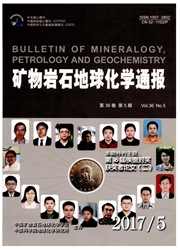

 中文摘要:
中文摘要:
为研究新立萤石矿床成矿液体特征,对矿床中的萤石包裹体进行了研究。结果表明,萤石中主要发育液相CH_4包裹体、气液两相H_2O-NaCl-CH_4体系包裹体和气液固三相包裹体。包裹体均一温度峰值为240~300℃,盐度为14%~22%NaCleqv,捕获压力为135~222MPa,具有超压特征。包裹体成分以CH_4为主,其次为H_2O,含有少量CO_2、C_2H_4和H_2S等组分。显微测温和激光拉曼分析结果表明,萤石成矿流体与MVT铅锌矿成矿流体类似,且具有油田卤水的特征。萤石矿的形成与古气藏的破坏密切相关,其成矿时间明显晚于MVT铅锌矿。
 英文摘要:
英文摘要:
Through a study of fluid inclusions in fluorite of the Xinli fluorite deposit in the Nanjiang area,this paper aims to reveal the characteristics,origin and possible metallogenic time of the metallogenic fluids,and then further to discuss genetic relationship among the fluorite deposit,the paleo-hydrocarbon reservoir,and the MVT lead-zinc deposit. Fluid inclusions in fluorites of the Xinli fluorite deposit are dominated with liquid methane inclusions,aqueous-vapor inclusions of H_2O-NaCl-CH_4 system,and daughter-bearing three-phase inclusions. Homogenization temperatures,salinities and trap pressures of fluid inclusions range mainly from 240℃ to 300℃,from 14% to 22% Na Cleqv,and from 135MPa to222MPa,respectively,suggesting fluid inclusions were formed under an overpressure environment. The composition of fluid inclusions includes major CH_4 and H_2O,and minor CO_2,C_2H_4 and H_2S. Based on results of Micro-thermometry and Raman spectrum,both of the metallogenic fluids in the fluorite deposit and MVT lead-zinc deposit are similar to oilfield brine. The formation of the fluorite deposit is closely related to the damage of the paleo-gas reservoir,but is obviously later than the formation of the MVT lead-zinc deposit.
 同期刊论文项目
同期刊论文项目
 同项目期刊论文
同项目期刊论文
 期刊信息
期刊信息
